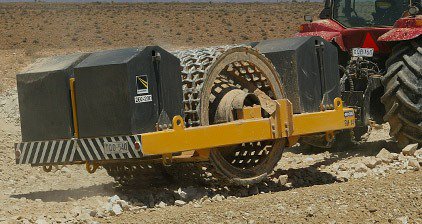Types of roller
Contents |
[edit] Introduction
Rollers are a type of construction plant used for compacting materials such as soil, gravel, sand, road surfaces and so on. The material can be compacted by vibration, impact loading, kneading, and direct pressure. Different types of roller can be used depending on the requirements of the project and the type of material that needs to be compacted.
[edit] Cylindrical roller
This is a traditional type of roller that is relatively lightweight and can be handled manually or, as was common throughout history, by animals such as oxen or horses. It is usually made of iron, concrete or stone and generally measures around 1 m in diameter and 1.5 m in length. The ground pressure that can be generated by a cylindrical roller is typically around 7 kg/cm2.
[edit] Sheepsfoot roller
Sheepsfoot rollers consist of a steel drum on which round or rectangular protrusions known as ‘lugs’ or ‘feet’ are fixed. There are different types of lug, such as spindle-shaped with widened base, prismatic and clubfoot. Rollers can also be static or vibratory.
The drum’s weight can be increased by ballasting with water, damp sand, or by mounting steel sections.
They are commonly used for compacting fine-grained soils such as heavy and silty clays. They are often used for compacting soils in dams, embankments and subgrade layers in pavements, road and railway projects.
The amount of soil compaction is governed by:
- The weight of the roller.
- The area of each lug.
- The number of lugs in contact with the ground.
- Total number of lugs per drum.
In general, 10 to 20 passes are required to provide complete coverage of the soil, and usually, the top layer of the consolidated soil will need to be finished with a smooth wheel roller.
[edit] Pneumatic tyred roller
Also known as rubber tyred rollers, these consist of a heavily-loaded wagon with several rows of closely-spaced tyres. They provide uniform pressure throughout the width covered, and are often used in pavement subgrade works, as they are suitable for compacting uniform coarse soils and rocks. They are also used to finish embankments compacted by sheepsfoot rollers
The factors which affect the amount of compaction that can be achieved are the weight, tyre inflation pressure and the area of contact.
[edit] Smooth wheeled roller
This type of roller incorporates a large steel drum at the front and one or two wheels or drums at the rear. If there is one wheel at the rear they are known as tandem rollers, and three-wheeled rollers if there are two wheels at the rear.
The weight of a tandem roller ranges from 2-8 tonnes, whereas the weight of a three-wheeled roller ranges from 8-10 tonnes. The ground pressure exerted by tandem rollers is typically around 10-17 kg/cm2.
The performance of a smooth wheeled roller depends on the load per cm width transferred to the soil (which is derived from the gross weight of the drum), and the drum diameter. They are most suitable for consolidating stone, gravel, sand, hardcore and ballast, but are not suitable for embankments, soft subgrades or uniform sands.
[edit] Vibratory roller
This type of roller is fitted with one or two smooth surfaced steel drums measuring 0.9-1.5 m in diameter, and 1.2-1.8 m in width. The drums vibrate by the rotation of an eccentric shaft inside. They are commonly used for compacting granular base courses and sometimes for asphalt, and are useful for compacting to greater depths.
They have higher outputs and improved performance compared to other rollers, but also generally come at a higher cost.
[edit] Grid roller
Grid rollers have a cylindrical heavy steel surface comprising a network of steel bars which form a grid with square-shaped holes. It is common for the roller to be ballasted with concrete blocks. This type of roller is generally a towed unit, and provides high contact pressure but minimal kneading action.
They are typically used for the compaction of well-graded coarse soils and weathered rocks, often in subgrade and sub-base road projects. They are not suitable for clayey soils, silty clays or uniform soils.
[edit] Find out more
[edit] Related articles on Designing Buildings Wiki
Featured articles and news
A five minute introduction.
50th Golden anniversary ECA Edmundson apprentice award
Showcasing the very best electrotechnical and engineering services for half a century.
Welsh government consults on HRBs and reg changes
Seeking feedback on a new regulatory regime and a broad range of issues.
CIOB Client Guide (2nd edition) March 2025
Free download covering statutory dutyholder roles under the Building Safety Act and much more.
AI and automation in 3D modelling and spatial design
Can almost half of design development tasks be automated?
Minister quizzed, as responsibility transfers to MHCLG and BSR publishes new building control guidance.
UK environmental regulations reform 2025
Amid wider new approaches to ensure regulators and regulation support growth.
The maintenance challenge of tenements.
BSRIA Statutory Compliance Inspection Checklist
BG80/2025 now significantly updated to include requirements related to important changes in legislation.
Shortlist for the 2025 Roofscape Design Awards
Talent and innovation showcase announcement from the trussed rafter industry.
OpenUSD possibilities: Look before you leap
Being ready for the OpenUSD solutions set to transform architecture and design.
Global Asbestos Awareness Week 2025
Highlighting the continuing threat to trades persons.
Retrofit of Buildings, a CIOB Technical Publication
Now available in Arabic and Chinese aswell as English.
The context, schemes, standards, roles and relevance of the Building Safety Act.
Retrofit 25 – What's Stopping Us?
Exhibition Opens at The Building Centre.
Types of work to existing buildings
A simple circular economy wiki breakdown with further links.
A threat to the creativity that makes London special.





























